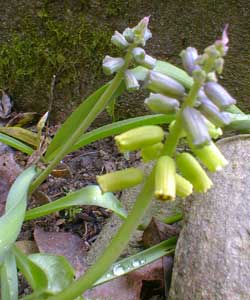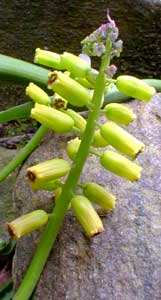
'Golden Fragrance'
Yellow Grape Hyacinths
Muscari macrocarpum (formerly M. moschatum var. flavum) is a yellow grape hyacinth quite distinct from the usual blues. It had long been rare as a garden offerings because it reproduces slowly. Some have found it to be difficult to establish in cooler climates, but it was given the Award of Garden Merit in 1948, & one of the criteria for this award is ease of growth.
A brighter sulfur-yellow strain was discovered by Ethel Savory, & it additionally proved to be much more cold-hardy & very free-flowering. Stocks were developed in Holland by De Goede Bulbivaria, who patented the strain in 1999 with the cultivar name 'Golden Fragrance,' alluding to its color & to its scent, which smells a bit like a mix of gardenia & banana.
 In 2003 it was introduced throughout the American market, still somewhat expensive due to limited stocks.
In 2003 it was introduced throughout the American market, still somewhat expensive due to limited stocks.Suitable for zones 6 through 9; zone 5 demands it be provided a winter mulch to protect the corm. It can reputedly be stretched down to zone 3, but as it is easily frost-damaged, that's hard for me to imagine. In temperate areas it blooms March & April, or April & May. Ours had buds in March, & began flowering early in April.
The buds start out dusky purple or greenish violet amidst thick blades of tapering grey-green foliage, but by the time the buds are opened, they become a loose raceme of small yellow "grapes." They are not as grape-like as other muscaris, however, because they are nearly tubular, though the perianth is "pinched" nearly shut as with blue grape hyacinths. When they go to seed, the winged capsules have their own ornamental appeal.
Bulbs are planted in autumn 4" deep & 4" apart. They want full sun to bright shade, tolerating more shade the further south they are grown, but requiring to be sun-warmed during summer dormancy so that a sunny placement is best to insure that they will naturalize
I selected a location for them I believed would be sunny enough, but I miscalculated sun angles, so the resulting spring flowers were poorly upheld on stems weaker than expected, & the grass excessively floppy. I'll move them to a better location, & add more of them next autumn, as even with their tepid performance in too much shade, they were very nice.
Although the corm is a bit bigger than for most muscaris, with unusual thick white perennial roots beneath, the plant itself is small, reaching only four or six inches of height. If the foliage were lifted straight up it might reach ten inches or a foot, but it curves back on itself to better display its central blossom.
This Aegean native is found in eastern Crete, Samos, the Amorgos Isles, & in southwest Turkistan. On Crete, it was formerly sacred to the Mother Goddess, & is even today called Kore, the "Maid," after Persephone.